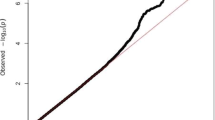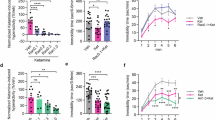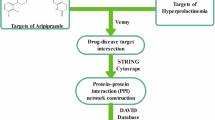Abstract
Aim:
Aripiprazole is an antipsychotic agent to treat schizophrenia, which acts through dopamine D2 partial agonism, serotonin 5-HT1A partial agonism and 5-HT2A antagonism. This study was designed to evaluate the neurobehavioral effects and genotoxic/mutagenic activities of the agent, as well as its effects on lipoperoxidation.
Methods:
Open field and inhibitory avoidance tasks were used. Thirty min before performing the behavioral tasks, adult male CF-1 mice were administered aripiprazole (1, 3 or 10 mg/kg, ip) once for the acute treatment, or the same doses for 5 d for the subchronic treatment. Genotoxic effects were assessed using comet assay in the blood and brain tissues. Mutagenic effects were evaluated using bone marrow micronucleus test. Lipoperoxidation was assessed with thiobarbituric acid reactive substances (TBARS).
Results:
Acute and subchronic treatments significantly decreased the number of crossing and rearing in the open field task. Acute treatment significantly increased the step-down latency for both the short- and long-term memory in the inhibitory avoidance task. Subchronic treatments with aripiprazole (3 and 10 mg/kg) caused significant DNA strain-break damage in peripheral blood but not in the brain. Mutagenic effect was not detected in the acute and subchronic treatments. Nor TBARS levels in the liver were affected.
Conclusion:
Aripiprazole improved memory, but could impair motor activities in mice. The drug increased DNA damage in blood, but did not show mutagenic effects, suggesting that it might affect long-term genomic stability.
Similar content being viewed by others
Log in or create a free account to read this content
Gain free access to this article, as well as selected content from this journal and more on nature.com
or
References
Harvey PD, Green MF, Keefe RS, Velligan DI . Cognitive functioning in schezophrenia: a consenses on its role in the definition and evaluation of effective treatments for the illness. J Cli Psychiatry 2004; 65: 361–72.
Velligan DI, Kern RS, Gold JM . Cognitive rehabilitation for schizophrenia and the putative role of motivation and expectancies. Schizophr Bull 2006; 32: 474–85.
Kern RS, Hartzell AM, Izaguirre B, Hamilton AH . Declarative and nondeclarative memory in schizophrenia: what is impaired? What is spared? J Clin Exp Neuropsychol 2010; 32: 1017–27.
Ishiyama T, Tokuda K, Ishibashi T, Ito A, Ohno Y . Lurasidone (SM-13496), a novel atypical antipsychotic drug, reverses MK-801-induced impairment of learning and memory in the rat passive-avoidance test. Eur J Pharmacol 2007; 572: 160–70.
Enomoto T, Ishibashi T, Tokuda K, Ishiyama T, Toma S, Ito A . Lurasidone reverses MK-801-induced impairment of learning and memory in the Morris water maze and radial-arm maze tests in rats. Behav Brain Res 2008; 186: 197–207.
Kern KS, Green MF, Lornblatt BA, Owen JR, McQuade RD, Larson WH, et al. The neurocognitive effects of aripiprazole: an open-label comparison with olanzapine. Psychopharmacology 2006; 187: 312–20.
Kane JM, Larson WH, Saha AR, McQuade RD, Ingenito GG, Zimbroff DL . Efficacy and safety of aripiprazole and haloperidol versus placebo in patients with schizophrenia and schizoaffective disorder. J Clin Psychiatry 2002; 63: 763–11.
Miller DD, Eudicone JM, Pikalov A, Kim E . Comparative assessment of the incidence and severity of tardive dyskinesia in patients receiving aripiprazole or haloperidol for treatment of schizophrenia: a post hoc analysis. J Clin Psychiatry 2007; 68: 1901–6.
Nagai T, Murai R, Matsui K, Komei H, Noda Y, Furukawa H, et al. Aripiprazole ameliorates phencyclidine-induced impairment of recognition memory through dopamine D1 and serotonin 5-HT1A receptors. Psychopharmacology 2009; 202: 315–28.
Pereira P, Tysca D, Oliveira P, da Silva Brum LF, Picada JN, Ardenghi P . Neurobehavioral and genotoxic aspects of rosmarinic acid. Pharmacol Res 2005; 52: 199–203.
Tice RR, Agurell E, Anderson D, Burlinson B, Hartmann A, Kobayashi Y, et al. Single cell gel/comet assay: guidelines for in vitro and in vivo genetic toxicology testing. Environ Mol Mutagen 2000; 35: 206–21.
Picada JN, Flores DG, Zettler CG, Marroni NP, Roesler R, Henriques JAP . DNA damage in brain cells of mice treated with an oxidized form of apomorphine. Mol Brain Res 2003; 114: 80–5.
Pereira P, Oliveira P, Ardenghi P, Rotta LN, Henriques JAP, Picada JN . Neuropharmacological analysis of caffeic acid in rats. Basic Clin Pharmacol Toxicol 2006; 99: 374–8.
Pereira P, Gianesini J, da Silva Barbosa C, Cassol GF, Von Borowski RG, Kahl VF, et al. Neurobehavioral and genotoxic parameters of duloxetine in mice using the inhibitory avoidance task and comet assay as experimental models. Pharmacol Res 2009; 59: 57–61.
Mavournin KH, Blakey DH, Cimino MC, Salamone MF, Heddle JA . The in vivo micronucleus assay in mammalian bone marrow and peripheral blood. A report of the US Environmental Protection Agency Gene-Tox Program. Mutat Res 1990; 239: 29–80.
Picada JN, da Silva KV, Erdtmann B, Henriques AT, Henriques JAP . Genotoxic effects of structurally related beta-carboline alkaloids. Mutat Res 1997; 379: 135–49.
Rodrigues CR, Dias JH, Semedo JG, da Silva J, Ferraz AB, Picada JN . Mutagenic and genotoxic effects of Baccharis dracunculifolia (DC). J Ethnopharmacol 2009; 124: 321–4.
Esterbauer H, Cheeseman KH . Determination of aldehydic lipid peroxidation products: malonaldehyde and 4-hydroxynonenal. Methods Enzymol 1990; 186: 407–21.
Lowry H, Rosebrough MJ, Farr AL . Protein measurement with the foline reagent. J Biol Chem 1951; 193: 265–75.
Bespalov A, Jongen-Rêlo AL, Van Gaalen M, Harich S, Schoemaker H, Gross G . Habituation deficits induced by metabotropic glutamate receptor 2/3 receptor blockade in mice: reversal by antipsychotic drugs. J Pharmacol Exp Ther 2007; 320: 944–50.
Jerlhag E . The antipsychotic aripiprazole antagonizes the ethanol- and amphetamine-induced locomotor stimulation in mice. Alcohol 2008; 42: 123–7.
Izquierdo I, Medina JH . Memory formation: the sequence of biochemical events in the hippocampus and its connections to activity in other brain structures. Neurobiol Learn Mem 1997; 68: 285–316.
Rossato JL, Bonini JS, Coitinho AS, Vianna MR, Medina JH, Cammarota M, et al. Retrograde amnésia induced by drugs acting on different molecular systems. Behav Neurosci 2004; 118: 563–8.
Rossato JI, Zinn CG, Furini C, Bevilaqua LR, Medina JH, Cammarota M, et al. A link between the hippocampal and the striatal memory systems of the brain. An Acad Bras Cienc 2006; 78: 515–23.
Kessler RM . Aripiprazole: what is the role of dopamine D2 receptor partial agonism? Am J Psychiatry 2007; 164: 1310–2.
Hartmann A, Agurell E, Beevers C, Brendler–Schwaab S, Burlinson B, Clay P, et al. Recommendations for conducting the in vivo alkaline Comet assay. Mutagenesis 2003; 18: 45–51.
Brambilla G, Mattioli F, Martelli A . Genotoxic and carcinogenic effects of antipsychotics and antidepressants. Toxicology 2009; 261: 77–88.
McLoughlin GA, Ma D, Tsang TM, Jones DN, Cilia J, Hill MD, et al. Analyzing the effects of psychotropic drugs on metabolite profiles in rat brain using 1H NMR spectroscopy. J Proteome Res 2009; 8: 1943–52.
Yang TT, Wang SJ . Aripiprazole and its human metabolite OPC14857 reduce, through a presynaptic mechanism, glutamate release in rat prefrontal cortex: possible relevance to neuroprotective interventions in schizophrenia. Synapse 2008; 62: 804–18.
Park SW, Lee JG, Ha EK, Choi SM, Cho HY, Seo MK, et al. Differential effects of aripiprazole and haloperidol on BDNF-mediated signal changes in SH-SY5Y cells. Eur Neuropsychopharmacol 2009; 19: 356–62.
Urichuk L, Prior TI, Dursun S, Baker G . Metabolism of atypical antipsychotics: involvement of cytochrome P450 enzymes and relevance for drug-drug interactions. Curr Drug Metab 2008; 9: 410–8.
Waade RB, Christensen H, Rudberg I, Refsum H, Hermann M . Influence of comedication on serum concentrations of aripiprazole and dehydroaripiprazole. Ther Drug Monit 2009; 31: 233–8.
Halliwell B . Role of free radicals in the neurodegenerative diseases, therapeutic implications for antioxidant treatment. Drugs Aging 2001; 18: 685–716.
Arvindakshan M, Sitasawad S, Debsikdar V, Ghate M, Evans D, Horrobin DF, et al. Essential polyunsaturated fatty acid and lipid peroxide levels in never-medicated and medicated schizophrenia patients. Biol Psychiatry 2003; 53: 56–64.
Gama CS, Salvador M, Andreazza AC, Lobato MI, Berk M, Kapczinski F, et al. Elevated serum thiobarbituric acid reactive substances in clinically symptomatic schizophrenic males. Neurosci Lett 2008; 433: 270–3.
Martins MR, Petronilho FC, Gomes KM, Dal-Pizzol F, Streck EL, Quevedo J . Antipsychotic-induced oxidative stress in rat brain. Neurotox Res 2008; 13: 63–9.
Eren I, Nazıroglu M, Demirdas A . Protective effects of lamotrigine, aripiprazole and escitalopram on depression-induced oxidative stress in rat brain. Neurochem Res 2007; 32: 1188–95.
Streck EL, Rezin GT, Barbosa LM, Assis LC, Grandi E, Quevedo J . Effect of antipsychotics on succinate dehydrogenase and cytochrome oxidase activities in rat brain. Naunyn Schmiedeberg Arch Pharmacol 2007; 376: 127–33.
Acknowledgements
This work was supported by CNPq (Conselho Nacional de Desenvolvimento Científico e Tecnológico) and FAPERGS (Fundação de Amparo à Pesquisa do Estado do Rio Grande do Sul), Brazil.
Author information
Authors and Affiliations
Corresponding author
Rights and permissions
About this article
Cite this article
Picada, J., Dos Santos, B., Celso, F. et al. Neurobehavioral and genotoxic parameters of antipsychotic agent aripiprazole in mice. Acta Pharmacol Sin 32, 1225–1232 (2011). https://doi.org/10.1038/aps.2011.77
Received:
Accepted:
Published:
Issue date:
DOI: https://doi.org/10.1038/aps.2011.77
Keywords
This article is cited by
-
Genotoxicity of Psychotropic Drugs in Experimental and Clinical Studies
Neuroscience and Behavioral Physiology (2023)
-
Spironolactone alleviates schizophrenia-related reversal learning in Tcf4 transgenic mice subjected to social defeat
Schizophrenia (2022)
-
Interaction between interleukin-1β and type-1 cannabinoid receptor is involved in anxiety-like behavior in experimental autoimmune encephalomyelitis
Journal of Neuroinflammation (2016)
-
Diminished serum repetin levels in patients with schizophrenia and bipolar disorder
Scientific Reports (2015)



